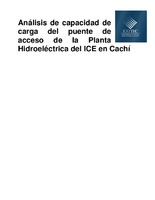"Análisis de capacidad de carga del puente de acceso de la Planta Hidroeléctrica del ICE en Cachí"
Abstract
The following work consists in the evaluation of the capacity and performance of an existing bridge. It is required to support the transportation of a 50 ton high tension transformer, which is part of the equipment to be taken to the Cachi´s Hydraulic Plant Slave Station Raiser. The above problem rises because of the need of the ICE to bring up to date such Plant with the replacement of the generation and transformation equipment.
In order to arrive at this location it is necessary to cross a 40 year old bridge built with post tensed concrete. It has two beam spans simply supported, one of them is 13.03m and the other one is 17.86m long. The carrying beams are reinforced with post tensed steel and structural steel passive bars. It is important to say that these structures were designed by Productos de Concreto and ICE.
As the starting point we proceeded to write the goals to be accomplished so that we can have a logical and neat work. The following are such goals:
Gathering information.
Site visits.
Previous information about any problems, if necessary.
Slab’s flexion analysis.
Slab’s shear analysis.
Beam’s normal strength analysis.
Beam’s flexion analysis.
Beam’s flexion analysis.
In order to begin the analysis, it was necessary to put in order by steps the strategy to follow. First of all we made an investigation about the actual conditions. We visited the site, we checked out the drawings y searched for the bibliography about the international designed code subject, specially AASHTO, since this bridge was made under this code, and related books about pre-stress and post-tensed concrete.
It was necessary to search about several types of transportation (such as tractor and platform) to be used and thus create a critical model to get to know the performance of the superstructure (beams and slabs) under the least favorable conditions. Once it is finished this stage, we took as the components of the model a 7 ton truck (10m long) plus the 50 ton high tension transformer, that the ICE requires to move to the site, with a total of 60 ton to be transported.
Afterwards it was necessary to use these components to create the critical model under shear conditions so as the flexion.
Then we proceeded to make a theoretical analysis by using as a basis the already said in the pre-stress concrete design literature. In this section we got the momentum and nominal shears to know the bridge capacity and be able to compare it with the previous data and give the respective conclusion.
From the revealed data into the analysis by flexion, we realized that there is an acting maximum momentum of 2.1ton-m, and it has a supporting capacity of 3.19ton-m, it is important to mention that this slab is not pre-stress; it is a reinforced concrete slab. Besides we got in the same analysis (by flexion), for each supporting beam, the maximum momentum acting is 112.73 ton-m, and has a supporting capacity of129.43ton-m.
In the shear analysis case of the slab we got a maximum acting shearing strength of 7,58ton and a maximum shear that can bear the slab of 7.9 ton. When analyzing the beam by shear it can be seen that the acting shearing strength is 22.6 ton, and the beam has a nominal capacity of 23.6 ton.
Because the results revealed that the superstructure supports all of the acting loads, it is not necessary to add any type of reinforcement. It is important to mention that the substructure was checked prior to this analysis by the ICE. From this study we concluded that the supporting capacity of the substructure is way beyond what it is needed. Besides, the ICE studied the neoprene bearing supports reaching to the same conclusion.
It is important to mention that the transportation of the transformer was made on Friday 2nd, 2004 and the bridge resisted it properly. For the saying transportation it was used lighter equipment than the one used for the analysis in this work of checking capacity. It was used a trailer of 10 m long, weighing aprox. 6ton and, having in the rear just two tandem axes. However, the lowest weight, the fact that the trailer had two axes instead of three, concentrates more the loads and can cause problems. For the actual study we do not use trailers of that type because overpass the single axe weight allowed by the MOPT to be moving on the national roads
We have to point out that if it is necessary for the ICE to move to this plant heavier equipment, they should do the previous respective study So this, although the theoretical data of capacity was far away from the acting loads, the range of safety for the slab’s shearing strength is small.
Besides we have to keep in mind that being heavy equipments it can not be used any type of trailer to avoid any delay and accidents.
Description
Proyecto de investigación. Instituto Tecnológico de Costa Rica. Escuela de Ingeniería en Construcción, 2004


